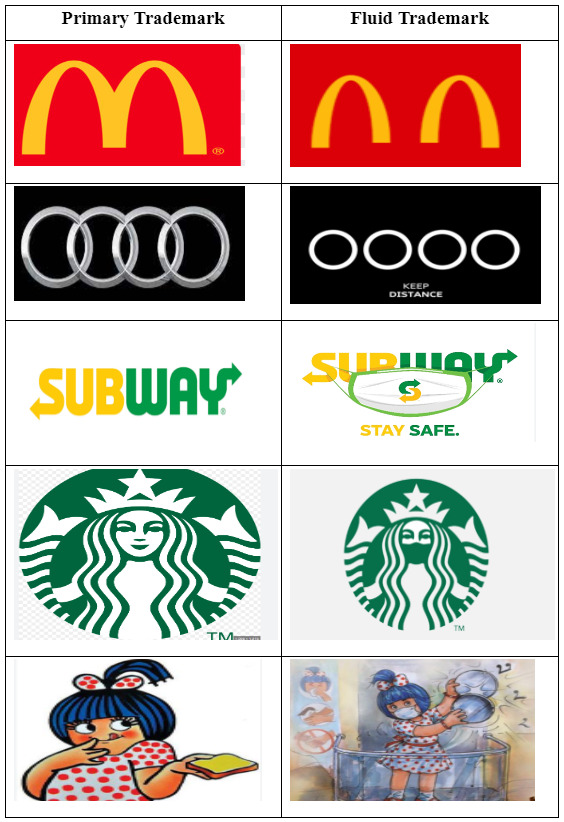With the growing digitization in literally every field, trademarks are also taking up a modern approach that helps reach a wider customer base with the help of “Fluid Trademarks.”
Fluid trademarks refer to a method of capturing different versions of a trademark, which may not be so different from each other. Fluid trademarks share the same characteristics as traditional ones. They can be a word, phrase, symbol, or design identifying and distinguishing a product or service source.
It is a mark based on the original trademark but altered deliberately to appear as a variant of the original trademark. However, the target market remains the same with a slight alteration but retains the basic elements of the original mark and still can be identified by the consumers.
There are many instance for the fluid trademark like the “Amul Girl”, “Google Doodle” In covid-19 many brands had used Fluid Trademarks to promote social distancing, e.g.
- McDonald’s had their iconic yellow ‘M’ in the red-background re-designed,
- The wheels in the four-wheel logo of Audi were spaced farther apart,
- Subways logo has mask on it
- The Starbucks mermaid and Amul girl has a mask over face
- Google Doodle changes in sync with the important days and birthdays.


Fluid Trademarks have evolved into a dynamic marketing tool. Fluid trademarks are variants of registered trademarks that coexist with the underlying marks and are created to increase market demand and build brand loyalty.
They can be registered as a series of marks – several trademarks are registered in respect of the same or similar goods or services – while they resemble each other in their material particulars, they can differ concerning the non-distinctive elements (i.e., ornamental changes) that do not substantially affect their identity. Brand owners need to be aware of the risks.
Using fluid marks is a risky business since each alteration in the logo deviates from the original trademark brand’s identity. In addition, for brands that aren’t well-known, using a fluid mark might not be the best idea because it may confuse the people about the brand’s original trademark. Moreover, there is a high chance of diluting a trademark by having too many fluid trademarks. However, that might not always be the case.
Fluid Trademark in India:
Fluid trademarks are not protected under Indian Intellectual Property law. However, the Indian Trade Marks Act, 1999 and the Indian Copyright Act, 1957 are enough to accommodate the same under them.
There are a few provisions that can provide the required protection to the fluid trademarks. For Instance, a fluid trademark can be protected as a series mark – the base features may remain the same, but the non-distinctive elements, i.e., ornamental changes not substantially affecting their identity, can differ – under Section 15 of the Trade Marks Act, 1999.
Section 15 of the Trade Marks Act, 1999 – Registration of parts of trademarks and trademarks as a series.—
- Where the proprietor of a trademark claims to be entitled to the exclusive use of any part thereof separately, he may apply to register the whole and the part as separate trademarks.
- Each such separate trade mark shall satisfy all the conditions applying to and have all the incidents of an independent trademark.
- Where a person claiming to be the proprietor of several trade marks in respect of the same or similar goods or services or description of goods or description of services, which, while resembling each other in the material particulars thereof, yet differ in respect of—
- statement of the goods or services in relation to which they are respectively used or proposed to be used; or
- statement of number, price, quality or names of places; or
- other matter of a non-distinctive character which does not substantially affect the identity of the trade mark; or
-
Colour, seeks to register those trademarks, they may be registered as a series in one registration.
Case law:
In Proctor and Gamble v. Joy Creators
The Delhi High Court ruled that “It will be sufficient if the plaintiff can show that the trademark adopted by the Defendant resembles its trademark in a substantial degree, on account of extensive use of the main features found in a trademark.” Thus, a company’s fluid trademark, even if not registered, can avail for common law protection by proving similarity of a substantial degree.
Conclusion:
In this digital era, fluid trademarks are vital because they have significant trade worldwide. Fluid marks help brands grow. They bring greater awareness of the brand, potentially leading to customers recognising the brand as dynamic. Redesigning a trademark in different ways while retaining its original elements will enhance rights in the original mark by expanding its market reach, thus strengthening the registered trademark.